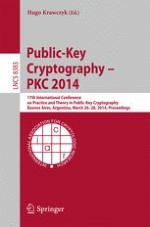2014 | Buch
Public-Key Cryptography – PKC 2014
17th International Conference on Practice and Theory in Public-Key Cryptography, Buenos Aires, Argentina, March 26-28, 2014. Proceedings
herausgegeben von: Hugo Krawczyk
Verlag: Springer Berlin Heidelberg
Buchreihe : Lecture Notes in Computer Science
